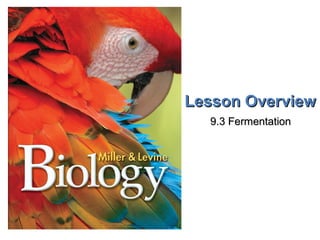CVA Biology I - B10vrv3093
•Als PPT, PDF herunterladen•
0 gefällt mir•560 views
Copyright - Adapted from Pearson
Melden
Teilen
Melden
Teilen

Empfohlen
Weitere ähnliche Inhalte
Was ist angesagt?
Was ist angesagt? (20)
Chapter 10 Respiration Lesson 1 - Aerobic and Anaerobic Respiration and the E...

Chapter 10 Respiration Lesson 1 - Aerobic and Anaerobic Respiration and the E...
Andere mochten auch
Andere mochten auch (18)
Ähnlich wie CVA Biology I - B10vrv3093
Ähnlich wie CVA Biology I - B10vrv3093 (20)
Bio 103 lecture 11_metbolism, enzymes, & respiration

Bio 103 lecture 11_metbolism, enzymes, & respiration
Kürzlich hochgeladen
Kürzlich hochgeladen (20)
[2024]Digital Global Overview Report 2024 Meltwater.pdf![[2024]Digital Global Overview Report 2024 Meltwater.pdf](data:image/gif;base64,R0lGODlhAQABAIAAAAAAAP///yH5BAEAAAAALAAAAAABAAEAAAIBRAA7)
![[2024]Digital Global Overview Report 2024 Meltwater.pdf](data:image/gif;base64,R0lGODlhAQABAIAAAAAAAP///yH5BAEAAAAALAAAAAABAAEAAAIBRAA7)
[2024]Digital Global Overview Report 2024 Meltwater.pdf
Understanding Discord NSFW Servers A Guide for Responsible Users.pdf

Understanding Discord NSFW Servers A Guide for Responsible Users.pdf
From Event to Action: Accelerate Your Decision Making with Real-Time Automation

From Event to Action: Accelerate Your Decision Making with Real-Time Automation
Breaking the Kubernetes Kill Chain: Host Path Mount

Breaking the Kubernetes Kill Chain: Host Path Mount
Automating Google Workspace (GWS) & more with Apps Script

Automating Google Workspace (GWS) & more with Apps Script
The Role of Taxonomy and Ontology in Semantic Layers - Heather Hedden.pdf

The Role of Taxonomy and Ontology in Semantic Layers - Heather Hedden.pdf
Mastering MySQL Database Architecture: Deep Dive into MySQL Shell and MySQL R...

Mastering MySQL Database Architecture: Deep Dive into MySQL Shell and MySQL R...
The Codex of Business Writing Software for Real-World Solutions 2.pptx

The Codex of Business Writing Software for Real-World Solutions 2.pptx
The 7 Things I Know About Cyber Security After 25 Years | April 2024

The 7 Things I Know About Cyber Security After 25 Years | April 2024
Boost PC performance: How more available memory can improve productivity

Boost PC performance: How more available memory can improve productivity
08448380779 Call Girls In Civil Lines Women Seeking Men

08448380779 Call Girls In Civil Lines Women Seeking Men
Apidays Singapore 2024 - Building Digital Trust in a Digital Economy by Veron...

Apidays Singapore 2024 - Building Digital Trust in a Digital Economy by Veron...
TrustArc Webinar - Stay Ahead of US State Data Privacy Law Developments

TrustArc Webinar - Stay Ahead of US State Data Privacy Law Developments
08448380779 Call Girls In Greater Kailash - I Women Seeking Men

08448380779 Call Girls In Greater Kailash - I Women Seeking Men
CVA Biology I - B10vrv3093
- 1. Lesson OverviewLesson Overview FermentationFermentation Lesson OverviewLesson Overview 9.3 Fermentation9.3 Fermentation
- 2. Lesson OverviewLesson Overview FermentationFermentation THINK ABOUT IT We use oxygen to release chemical energy from the food we eat, but what if oxygen is not around? Is there a pathway that allows cells to extract energy from food in the absence of oxygen?
- 3. Lesson OverviewLesson Overview FermentationFermentation Fermenation How do organisms generate energy when oxygen is not available?
- 4. Lesson OverviewLesson Overview FermentationFermentation Fermenation How do organisms generate energy when oxygen is not available? In the absence of oxygen, fermentation releases energy from food molecules by producing ATP.
- 5. Lesson OverviewLesson Overview FermentationFermentation Fermentation Fermentation is a process by which energy can be released from food molecules in the absence of oxygen. Fermentation occurs in the cytoplasm of cells.
- 6. Lesson OverviewLesson Overview FermentationFermentation Fermentation Under anaerobic conditions, fermentation follows glycolysis. During fermentation, cells convert NADH produced by glycolysis back into the electron carrier NAD+ , which allows glycolysis to continue producing ATP.
- 7. Lesson OverviewLesson Overview FermentationFermentation Alcoholic Fermentation Yeast and a few other microorganisms use alcoholic fermentation that produces ethyl alcohol and carbon dioxide. This process is used to produce alcoholic beverages and causes bread dough to rise.
- 8. Lesson OverviewLesson Overview FermentationFermentation Alcoholic Fermentation Chemical equation: Pyruvic acid + NADH Alcohol + CO2 + NAD+
- 9. Lesson OverviewLesson Overview FermentationFermentation Lactic Acid Fermentation Most organisms, including humans, carry out fermentation using a chemical reaction that converts pyruvic acid to lactic acid. Chemical equation: Pyruvic acid + NADH Lactic acid + NAD+
- 10. Lesson OverviewLesson Overview FermentationFermentation Energy and Exercise How does the body produce ATP during different stages of exercise?
- 11. Lesson OverviewLesson Overview FermentationFermentation Energy and Exercise How does the body produce ATP during different stages of exercise? For short, quick bursts of energy, the body uses ATP already in muscles as well as ATP made by lactic acid fermentation. For exercise longer than about 90 seconds, cellular respiration is the only way to continue generating a supply of ATP.
- 12. Lesson OverviewLesson Overview FermentationFermentation Quick Energy Cells normally contain small amounts of ATP produced during cellular respiration, enough for a few seconds of intense activity. Lactic acid fermentation can supply enough ATP to last about 90 seconds. However, extra oxygen is required to get rid of the lactic acid produced. Following intense exercise, a person will huff and puff for several minutes in order to pay back the built-up “oxygen debt” and clear the lactic acid from the body.
- 13. Lesson OverviewLesson Overview FermentationFermentation Long-Term Energy For intense exercise lasting longer than 90 seconds, cellular respiration is required to continue production of ATP. Cellular respiration releases energy more slowly than fermentation does. The body stores energy in the form of the carbohydrate glycogen. These glycogen stores are enough to last for 15 to 20 minutes of activity. After that, the body begins to break down other stored molecules, including fats, for energy.
- 14. Lesson OverviewLesson Overview FermentationFermentation Long-Term Energy Hibernating animals like this brown bear rely on stored fat for energy when they sleep through the winter.